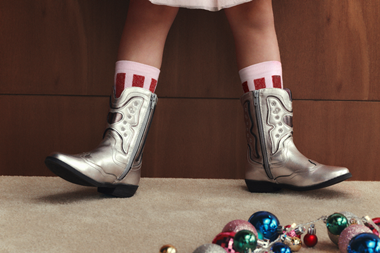2007 was another tough year for specialist shoe retailers and more recent news of floundering footwear players has done little to assuage fears for the new year. But, as Jennifer Creevy discovers, there is still a place for those with the right offer
The specialist shoe market has not been a comfortable place to be over the past couple of years. Well-known names, such as Dolcis and Stead & Simpson, are feeling the pinch and some shoe chains have only managed to limp into the new year.
So what has made footwear, a market that gave Britain some of its most venerable retail names, such a difficult sector to operate in today?
Take a look in most high street fashion shops and many of the larger supermarkets and the answer is clear. The chances are that, along with their staple products, grocers and clothing chains also sell shoes.
While the volume they sell may vary, they are all chipping away at the specialist footwear market. And the clout of fashion groups such as New Look and Primark, or supermarkets such as Tesco and Asda, has become so great that shoppers no longer need to go to a specialist store.
While many would argue there will always be a place for specialist footwear retailers, their market share has been eroding for years. Verdict Research estimates that footwear specialists claimed just 41.8 per cent of the market last year, down 1.1 percentage points against 2006. In the past five years, specialists have lost 6.5 percentage points of their share – the equivalent of£356 million in sales.
By contrast, the footwear market share by value of clothing retailers has been advancing. In 2002, clothing retailers comprised 24.4 per cent of the market. By 2007, that figure had leaped to 29.6 per cent. New Look has gained the most in the past five years, up from 0.9 per cent in 2002 to 3.4 per cent in 2007. Next is the second biggest gainer, up from 3.4 per cent to 4.7 per cent.
The intense competition does not bode well for footwear specialists. PricewaterhouseCoopers director Olivia Gillan says: “Some of the specialist footwear players will die a death this year. There are still many footwear retailers doing well, but the middle market is being squeezed and there is too much competition for everyone to survive.”
She says high-end players, such as Kurt Geiger, continue to do well because many consumers still want to treat themselves to higher priced purchases every so often. Value players, she adds, will survive if they continue to offer cheap imitations of fashionable trends, but there will be casualties in the middle ground.
Plenty of evidence that footwear retailers are struggling has emerged in the past year. Both Dolcis and Stead & Simpson hobbled through Christmas and their future is difficult to gauge. Dolcis, bought by Scottish entrepreneur John Kinnaird in late 2006, is seeking a new backer after its private equity partner Epic pulled out. Stead & Simpson, owner of Shoe Express, is up for sale and many commentators suggest the chances of selling the entire 350-store business are slim.
Tough times hit home
Kinnaird last week denied that Dolcis would go into administration (RW, last week), stating he was in the “final stages of securing a deal with a new backer”. He was confident that the plans he has set out for the business would remain in place and that although like-for-likes over the Christmas period were down, they were “getting much closer to a positive”. He did not deny, however, that the footwear market is tough and this year will be “hard work”.
Most footwear retailers would agree with his prediction. Stylo chairman and chief executive Michael Ziff says that while the Christmas trading period was “not a disaster”, it could have been better. He says the Sales are going well, but that it was tough in the run-up to Christmas and trade in the two-week period covering the last week of November and the first in December was a “pile of shite”.
Meanwhile, competition from fashion players and grocers will grow. Schuh managing director Colin Temple points to the opening of the Silverburn shopping centre in Glasgow late last year as an example of the intensity of competition in footwear.
“At Silverburn, there are just too many doors where shoppers can buy shoes,” he says. “The specialists there so far are Schuh, Office, Barratts, Dolcis, Clarks, Sole Trader and Kurt Geiger. Then there are the department stores and then the fashion retailers, including Hobbs, LK Bennett, River Island, Next and Zara. And this is mirrored in most high streets and shopping centres across the UK. There is too much competition – we need 20 to 30 per cent less footwear retailers in the market.”
According to Verdict, Clarks leads the shoe pack – with an estimated 9.7 per cent share of the market by value in 2007 – but the rest of the top five players are non-specialists. Marks & Spencer is in second place, with a 7.2 per cent share, followed by Sports Direct, JD Group and Next.
In Verdict’s top 10 by market share, the only other specialists are Stylo, which has a 4.1 per cent share and Shoe Zone/Shoefayre, with 3.4 per cent. They are nestled among JJB, New Look and Asda’s George.
New Look trading director Will Kernan says footwear is getting stronger for the fashion retailer and it is now an established part of its overall offer. “Footwear is important to us in the same way as accessories, because those products enable us to offer customers a one-stop shop for a complete outfit,” he says.
Kernan points out that, as shoppers become accustomed to fast fashion, they are demanding the same from shoes. “The pace of turnover for shoes needs to be in line with clothing because shoppers demand choice. We can offer a fashionable pair of shoes to go with an outfit at a very reasonable price” he says.
He also maintains that, while fashion retailers often have the backing to open stores or revamp existing ones, cash-strapped footwear specialists may not have invested in stores for some time. “The choice on the high street is immense and specialists that have let their stores become tired will pale in comparison with one of our new-format stores, or the likes of River Island,” he says.
Some specialist footwear retailers have been trying to freshen up their offer. Both Faith and Dolcis unveiled new-look stores late last year – the former debuting in Exeter in October and the latter opening in Glasgow in November. Even Stead & Simpson is understood to be opening a new-concept store in March this year.
But competition is not the only reason why footwear retailers have had a hard time over the past couple of years. They have also suffered in the face of price deflation and the impact of the anti-dumping tariffs imposed in April 2006.
Verdict retail analyst Carol Ratcliffe says deflation came to a halt in 2007, but this comes after at least a decade of falling footwear prices. While 2006 brought deflation of 2.8 per cent, there was a marginal 0.2 per cent increase in prices in 2007. “The main reason for the halt in deflation is the impact of the EU anti-dumping tariffs on leather footwear imports from two of the cheapest sourcing destinations; China and Vietnam,” she explains.
Ratcliffe says the tariffs affected the lower to middle end of the market, limiting the volume price competition through chains such as Shoe Zone and PriceLess, as well as non-specialists including the grocers and Primark.
Another nail in the coffin?
However, footwear retailers’ margins have also been hit severely by anti-dumping tariffs. Ratcliffe says that Stylo estimates its costs to source from China and Vietnam rose by between 5 and 16 per cent, while Clarks expects a£13 million negative impact on its profits for the year to January 2008.
“Though clothing specialists face the same problem, they are generally larger organisations with higher profitability, so they are better able to withstand this shock to their systems,” she says. “At a time when some footwear specialists are struggling to maintain their investment levels in store environments, the imposition of tariffs has left them in an even weaker position compared with their non-specialist rivals.”
For footwear specialists, this year will be about finding their niche. Some are increasing price points to go for a higher-end market, others are focusing on quality and many are increasing their buying teams to ensure they stay ahead of the trends.
“There’s an awful lot of much-of-a-muchness out there at the moment and some footwear retailers just don’t know who they are aiming at anymore,” says Office managing director Brian McCluskey. “It is all about finding your niche and then going after it.”
Temple would go as far as to say that there will be a correction in the market this year. “We know our customer and have a profitable business, but the market is still tough,” he says. “We need to hold steady until there is some sort of correction and we’re likely to see some of those retailers that have expanded rapidly or taken too many risks in order to fulfil a return for an investor go to the wall.”
Ziff agrees, saying it would be good for the market if “one or two footwear chains disappeared this year”. He warns: “Stocks will have to be kept very tight and it’s the year to be very nice to your bank manager.”
Footwear is braced for a difficult year, but there remain some strong brand names that will benefit if some weaker players fail. While some shoe specialists look as if they are on their uppers, others certainly have plenty of wear left in them yet.


























No comments yet